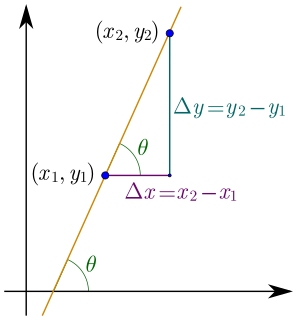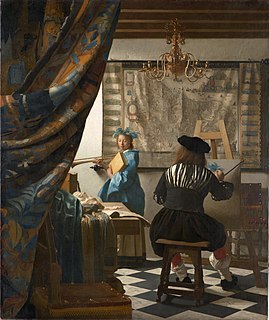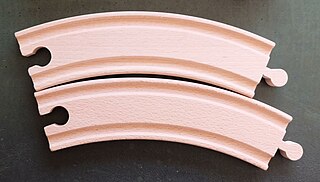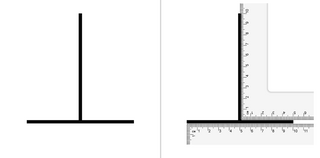
Analog television or analogue television is the original television technology that uses analog signals to transmit video and audio. In an analog television broadcast, the brightness, colors and sound are represented by rapid variations of either the amplitude, frequency or phase of the signal.

In mathematics, the slope or gradient of a line is a number that describes both the direction and the steepness of the line. Slope is often denoted by the letter m; there is no clear answer to the question why the letter m is used for slope, but its earliest use in English appears in O'Brien (1844) who wrote the equation of a straight line as "y = mx + b" and it can also be found in Todhunter (1888) who wrote it as "y = mx + c".

A sundial is a device that tells the time of day when there is sunlight by the apparent position of the Sun in the sky. In the narrowest sense of the word, it consists of a flat plate and a gnomon, which casts a shadow onto the dial. As the Sun appears to move across the sky, the shadow aligns with different hour-lines, which are marked on the dial to indicate the time of day. The style is the time-telling edge of the gnomon, though a single point or nodus may be used. The gnomon casts a broad shadow; the shadow of the style shows the time. The gnomon may be a rod, wire, or elaborately decorated metal casting. The style must be parallel to the axis of the Earth's rotation for the sundial to be accurate throughout the year. The style's angle from horizontal is equal to the sundial's geographical latitude.

The Poggendorff illusion is a geometrical-optical illusion that involves the misperception of the position of one segment of a transverse line that has been interrupted by the contour of an intervening structure. It is named after Johann Christian Poggendorff, the editor of the journal, who discovered it in the figures Johann Karl Friedrich Zöllner submitted when first reporting on what is now known as the Zöllner illusion, in 1860. The magnitude of the illusion depends on the properties of the obscuring pattern and the nature of its borders.

480i is a shorthand name for the video mode used for standard-definition analog or digital television in Caribbean, Myanmar, Japan, South Korea, Taiwan, Philippines, Laos, Western Sahara, and most of the Americas. The 480 identifies a vertical resolution of 480 lines, and the i identifies it as an interlaced resolution. The field rate, which is 60 Hz, is sometimes included when identifying the video mode, i.e. 480i60; another notation, endorsed by both the International Telecommunication Union in BT.601 and SMPTE in SMPTE 259M, includes the frame rate, as in 480i/30. The other common standard, used in the other parts of the world, is 576i.

In the visual arts, composition is the placement or arrangement of visual elements or 'ingredients' in a work of art, as distinct from the subject. It can also be thought of as the organization of the elements of art according to the principles of art.

The Hering illusion is one of the geometrical-optical illusions and was discovered by the German physiologist Ewald Hering in 1861. When two straight and parallel lines are presented in front of radial background, the lines appear as if they were bowed outwards. The Orbison illusion is one of its variants, while the Wundt illusion produces a similar, but inverted effect.

The Jastrow illusion is an optical illusion attributed to the Polish-American psychologist Joseph Jastrow. This optical illusion is known under different names: Ring-Segment illusion, Jastrow illusion, Wundt area illusion or Wundt-Jastrow illusion.

The Zöllner illusion is an optical illusion named after its discoverer, German astrophysicist Johann Karl Friedrich Zöllner. In 1860, Zöllner sent his discovery in a letter to physicist and scholar Johann Christian Poggendorff, editor of Annalen der Physik und Chemie, who subsequently discovered the related Poggendorff illusion in Zöllner's original drawing.
Horizontal scan rate, or horizontal frequency, usually expressed in kilohertz, is the frequency at which a CRT moves the electron beam from the left side of the display to the right and back, and therefore describes the number of horizontal lines displayed per second. CRT timings include some horizontal scans before the visible display, after it, and during the travel from bottom to top, so the horizontal scan rate does not directly correlate to visible display lines, unless the unseen lines are also known, but it can still be used to approximate the display lines, as the total blank time is usually a small but significant portion of the total lines.
A raster interrupt is an interrupt signal in a computer system which is used for display timing. It is usually, though not always, generated by a system's graphics chip as the scan lines of a frame are being readied to send to the monitor for display.
In human perception, contingent aftereffects are illusory percepts that are apparent on a test stimulus after exposure to an induction stimulus for an extended period. Contingent aftereffects can be contrasted with simple aftereffects, the latter requiring no test stimulus for the illusion/mis-perception to be apparent. Contingent aftereffects have been studied in different perceptual domains. For instance, visual contingent aftereffects, auditory contingent aftereffects and haptic contingent aftereffects have all been discovered.

The barberpole illusion is a visual illusion that reveals biases in the processing of visual motion in the human brain. This visual illusion occurs when a diagonally striped pole is rotated around its vertical axis (horizontally), it appears as though the stripes are moving in the direction of its vertical axis rather than around it.

The vertical–horizontal illusion is the tendency for observers to overestimate the length of a vertical line relative to a horizontal line of the same length. This involves a bisecting component that causes the bisecting line to appear longer than the line that is bisected. People often overestimate or underestimate the length of the bisecting line relative to the bisected line of the same length. This even happens if people are aware that the lines are of the same length.
In television broadcasting, VIT signals are a group of test signals inserted in the composite video signal. These signals are used to weight the transmission characteristics of the system between the test generator and the output of the demodulator, where the system includes the microwave links, or TVROs as well as the TV transmitters and the transposers. There are both ATSC and EBU standards for VIT.
Geometrical-optical illusions are visual illusions, also optical illusions, in which the geometrical properties of what is seen differ from those of the corresponding objects in the visual field.
Oblique effect is the name given to the relative deficiency in perceptual performance for oblique contours as compared to the performance for horizontal or vertical contours.
In astronomy, geography, and related sciences and contexts, a direction or plane passing by a given point is said to be vertical if it contains the local gravity direction at that point. Conversely, a direction or plane is said to be horizontal if it is perpendicular to the vertical direction. In general, something that is vertical can be drawn from up to down, such as the y-axis in the Cartesian coordinate system.
A schema for horizontal dials is a set of instructions used to construct horizontal sundials using compass and straightedge construction techniques, which were widely used in Europe from the late fifteenth century to the late nineteenth century. The common horizontal sundial is a geometric projection of an equatorial sundial onto a horizontal plane.
The Guangzhou–Kunming passageway is a high-speed railway passage connecting Guangzhou in Guangdong Province and Kunming in Yunnan Province, passing through Nanning en route. Announced in 2016 as part of the national "eight vertical and eight horizontal" high-speed railway network, the line is made up of the existing Nanning–Guangzhou high-speed railway and Nanning–Kunming high-speed railway lines. It is about 986 km in length, and is fully operational as of 28 December 2016.












